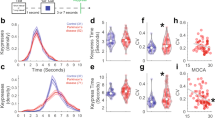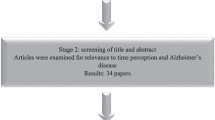Abstract
Background
Alterations in time awareness have been reported in dementia, particularly in Alzheimer's disease (AD) and frontotemporal dementia (FTD). However, the neurophysiological correlates underlying these alterations remain largely unexplored. This study aimed to investigate the neurophysiological correlates of altered time awareness in AD and FTD patients.
Methods
A total of 150 participants (50 AD patients, 50 FTD patients, and 50 healthy controls [HC]) underwent a standardized neuropsychological assessment, an altered time awareness survey, and transcranial magnetic stimulation (TMS) to assess cholinergic (short latency afferent inhibition—SAI), GABAergic (short interval intracortical inhibition—SICI), and glutamatergic (intracortical facilitation—ICF) circuits.
Results
In AD patients, the most frequent symptom was difficulty in ordering past events (52.0%), while FTD patients primarily struggled with estimating temporal intervals between events (40.0%). Significant differences were observed between HC and both patient groups, as well as between AD and FTD patients in their tendency to re-live past events. Binomial logistic regression analysis revealed that impairments in glutamatergic and cholinergic circuits significantly predicted the likelihood of participants manifesting altered time awareness symptoms.
Conclusions
This study provides novel insights into the neurophysiological correlates of altered time awareness in AD and FTD patients, highlighting the involvement of specific neurotransmitter circuits, particularly glutamatergic and cholinergic circuits. Further research is needed to explore the potential clinical implications and therapeutic targets arising from these findings.

Similar content being viewed by others
Data Availability
All study data, including raw and analysed data, and materials will be available from the corresponding author, A.B., upon reasonable request.
References
Gustavsson A, Norton N, Fast T, Frölich L, Georges J, Holzapfel D et al (2023) Global estimates on the number of persons across the Alzheimer’s disease continuum. Alzheimer’s Dement 19(2):658–670. https://doi.org/10.1002/alz.12694
Scheltens P, de Strooper B, Kivipelto M, Holstege H, Chételat G, Teunissen CE et al (2021) Alzheimer’s disease. Lancet (London, England) 397(10284):1577–1590. https://doi.org/10.1016/S0140-6736(20)32205-4
Lane CA, Hardy J, Schott JM (2018) Alzheimer’s disease. Eur J Neurol 25(1):59–70. https://doi.org/10.1111/ene.13439
Nicholas T, Spina S, Miller BL (2017) Frontotemporal dementia. Neurol Clin 35(2):339–374. https://doi.org/10.1016/j.ncl.2017.01.008
Knopman DS, Amieva H, Petersen RC, Chételat G, Holtzman DM, Hyman BT et al (2021) Alzheimer disease. Nat Rev Dis Primers 7(1). https://doi.org/10.1038/s41572-021-00269-y
Hogan DB, Jetté N, Fiest KM, Roberts JI, Pearson D, Smith EE et al (2016) The prevalence and incidence of frontotemporal dementia: a systematic review. Can J Neurol Sci 43(Suppl 1):S96–S109. https://doi.org/10.1017/cjn.2016.25
Rascovsky K, Hodges JR, Knopman D, Mendez MF, Kramer JH, Neuhaus J et al (2011) Sensitivity of revised diagnostic criteria for the behavioural variant of frontotemporal dementia. Brain 134(Pt 9):2456–2477. https://doi.org/10.1093/brain/awr179
Gorno-Tempini ML, Hillis AE, Weintraub S, Kertesz A, Mendez M, Cappa SF et al (2011) Classification of primary progressive aphasia and its variants. Neurology 76(11):1006–1014. https://doi.org/10.1212/WNL.0b013e31821103e6
Requena-Komuro M-C, Marshall CR, Bond RL, Russell LL, Greaves C, Moore KM et al (2020) Altered time awareness in dementia. Front Neurol 11:291. https://doi.org/10.3389/fneur.2020.00291
Basgol H, Ayhan I, Ugur E (2021) Time perception: a review on psychological, computational and robotic models. IEEE Trans Cogn Dev Syst 1. https://doi.org/10.1109/TCDS.2021.3059045
Buhusi CV, Oprisan SA, Buhusi M (2018) Biological and cognitive frameworks for a mental timeline. Front Neurosci 12:377. https://doi.org/10.3389/fnins.2018.00377
El Haj M, Moroni C, Samson S, Fasotti L, Allain P (2013) Prospective and retrospective time perception are related to mental time travel: evidence from Alzheimer’s disease. Brain Cogn 83(1):45–51. https://doi.org/10.1016/j.bandc.2013.06.008
Tulving E (2002) Episodic memory: from mind to brain. Annu Rev Psychol 53:1–25. https://doi.org/10.1146/annurev.psych.53.100901.135114
Pouthas V, George N, Poline J-B, Pfeuty M, Vandemoorteele P-F, Hugueville L et al (2005) Neural network involved in time perception: an fMRI study comparing long and short interval estimation. Hum Brain Mapp 25(4):433–441. https://doi.org/10.1002/hbm.20126
Üstün S, Kale EH, Çiçek M (2017) Neural networks for time perception and working memory. Front Hum Neurosci 11:83. https://doi.org/10.3389/fnhum.2017.00083
Wittmann, Marc (2009) The inner experience of time. Phil Trans R Soc London Ser B Biol Sci 364(1525):1955–1967. https://doi.org/10.1098/rstb.2009.0003
Jahn H (2013) Memory loss in Alzheimer’s disease. Dialogues Clin Neurosci 15(4):445–454
Buckner RL, Andrews-Hanna JR, Schacter DL (2008) The brain’s default network: anatomy, function, and relevance to disease. Ann N Y Acad Sci 1124:1–38. https://doi.org/10.1196/annals.1440.011
Morillon B, Kell CA, Giraud A-L (2009) Three stages and four neural systems in time estimation. J Neurosci 29(47):14803–14811. https://doi.org/10.1523/JNEUROSCI.3222-09.2009
MacDonald CJ, Fortin NJ, Sakata S, Meck WH (2014) Retrospective and prospective views on the role of the hippocampus in interval timing and memory for elapsed time. Timing Time Percept 2(1):51–61. https://doi.org/10.1163/22134468-00002020
Eichenbaum H (2014) Time cells in the hippocampus: a new dimension for mapping memories. Nat Rev Neurosci 15(11):732–744. https://doi.org/10.1038/nrn3827
Meck WH (1996) Neuropharmacology of timing and time perception. Cogn Brain Res 3(3–4):227–242. https://doi.org/10.1016/0926-6410(96)00009-2
Sandrini M, Manenti R (2009) La stimolazione magnetica transcranica nello studio delle funzioni cognitive. G Ital Psicol 26:347–372
McKhann GM, Knopman DS, Chertkow H, Hyman BT, Jack CR, Kawas CH et al (2011) The diagnosis of dementia due to Alzheimer's disease: recommendations from the National Institute on Aging-Alzheimer's Association workgroups on diagnostic guidelines for Alzheimer's disease. Alzheimer's Dement 263–269. https://doi.org/10.1016/j.jalz.2011.03.005
Benussi A, Dell’Era V, Cantoni V, Cotelli MS, Cosseddu M, Spallazzi M et al (2020) TMS for staging and predicting functional decline in frontotemporal dementia. Brain Stimul 13(2):386–392. https://doi.org/10.1016/j.brs.2019.11.009
Folstein MF, Folstein SE, McHugh PR (1975) Mini-mental state. J Psychiatr Res 12(3):189–198. https://doi.org/10.1016/0022-3956(75)90026-6
Husain M, Schott JM (2016) Oxford textbook of cognitive neurology and dementia. Oxford University press, Oxford
Desai AK, Grossberg GT, Sheth DN (2004) Activities of daily living in patients with dementia: clinical relevance, methods of assessment and effects of treatment. CNS Drugs 18(13):853–875. https://doi.org/10.2165/00023210-200418130-00003
Cummings JL, Mega M, Gray K, Rosenberg-Thompson S, Carusi DA, Gornbein J (1994) The neuropsychiatric inventory: comprehensive assessment of psychopathology in dementia. Neurology 44(12):2308–2314. https://doi.org/10.1212/WNL.44.12.2308
Reitan RM (1958) Validity of the trail making test as an indicator of organic brain damage. Percept Mot Skills 8(3): 271–276. https://doi.org/10.2466/pms.1958.8.3.271
Aprahamian I, Martinelli JE, Neri AL, Yassuda MS (2009) The clock drawing test a review of its accuracy in screening for dementia. Dement Neuropsychol 3(2):74–80. https://doi.org/10.1590/S1980-57642009DN30200002
Carlesimo GA, Buccione I, Fadda L, Graceffa A, Mauri M, Lorusso S, Bevilacqua G, Caltagirone C (2002) Standardizzazione di due test di memoria per uso clinico: Breve Racconto e Figura di Rey. Nuova Riv Neurol 12(1):1–13
Padovani A, Benussi A, Cantoni V, Dell’Era V, Cotelli M, Sofia; Caratozzolo, Salvatore, et al (2018) Diagnosis of mild cognitive impairment due to Alzheimer’s disease with transcranial magnetic stimulation. J Alzheimer’s Dis: JAD 65(1):221–230. https://doi.org/10.3233/JAD-180293
Benussi A, Cotelli MS, Cantoni V, Bertasi V, Turla M, Dardis A, Biasizzo J, Manenti R, Cotelli M, Padovani A, Borroni B (2019) Clinical and neurophysiological characteristics of heterozygous NPC1 carriers. JIMD Rep 49:80–88
Benussi A, Premi E, Cantoni V, Compostella S, Magni E, Gilberti N, Vergani V, Delrio I, Gamba M, Spezi R, Costa A, Tinazzi M, Padovani A, Borroni B, Magoni M (2020) Cortical inhibitory imbalance in functional paralysis. Front Hum Neurosci 14:1–7
Rossini PM, Burke D, Chen R, Cohen LG, Daskalakis Z, Di Iorio R, Di Lazzaro V, Ferreri F, Fitzgerald PB, George MS, Hallett M, Lefaucheur JP, Langguth B, Matsumoto H, Miniussi C, Nitsche MA, Pascual-Leone A, Paulus W, Rossi S, Rothwell JC, Siebner HR, Ugawa Y, Walsh V, Ziemann U (2015) Non-invasive electrical and magnetic stimulation of the brain, spinal cord, roots and peripheral nerves: basic principles and procedures for routine clinical and research application. An updated report from an I.F.C.N. Committee. Clin Neurophysiol 126:1071–1107
Kujirai T, Caramia MD, Rothwell JC, Day BL, Thompson PD, Ferbert A, Wroe S, Asselman P, Marsden CD (1993) Corticocortical inhibition in human motor cortex. J Physiol 471:501–519
Ziemann U, Rothwell JC, Ridding MC (1996) Interaction between intracortical inhibition and facilitation in human motor cortex. J Physiol 496:873–881
Buhusi CV, Meck WH (2005) What makes us tick? Functional and neural mechanisms of interval timing. Nat Rev Neurosci 6(10):755–765. https://doi.org/10.1038/nrn1764
Coull JT, Cheng R-K, Meck WH (2011) Neuroanatomical and neurochemical substrates of timing. Neuropsychopharmacology 36(1):3–25. https://doi.org/10.1038/npp.2010.113
Ivry RB, Schlerf JE (2008) Dedicated and intrinsic models of time perception. Trends Cogn Sci 12(7):273–280. https://doi.org/10.1016/j.tics.2008.04.002
Laje R, Cheng K, Buonomano DV (2011) Learning of temporal motor patterns: an analysis of continuous versus reset timing. Front Integr Neurosci 5:61. https://doi.org/10.3389/fnint.2011.00061
Allman MJ, Meck WH (2012) Pathophysiological distortions in time perception and timed performance. Brain 135(Pt 3):656–677. https://doi.org/10.1093/brain/awr210
Cosseddu M, Benussi A, Gazzina S, Alberici A, Dell’Era V, Manes M, Cristillo V, Borroni B, Padovani A (2020) Progression of behavioural disturbances in frontotemporal dementia: a longitudinal observational study. Eur J Neurol 27(2):265–272. https://doi.org/10.1111/ene.14071
Benussi A, Premi E, Gazzina S, Brattini C, Bonomi E, Alberici A, Jiskoot L, van Swieten JC, Sanchez-Valle R, Moreno F, Laforce R, Graff C, Synofzik M, Galimberti D, Masellis M, Tartaglia C, Rowe JB, Finger E, Vandenberghe R, de Mendonça A, Tagliavini F, Santana I, Ducharme S, Butler CR, Gerhard A, Levin J, Danek A, Otto M, Frisoni G, Ghidoni R, Sorbi S, Le Ber I, Pasquier F, Peakman G, Todd E, Bocchetta M, Rohrer JD, Borroni B, Genetic FTD Initiative (GENFI) (2021) Progression of behavioral disturbances and neuropsychiatric symptoms in patients with genetic frontotemporal dementia. JAMA Network Open 4(1):e2030194. https://doi.org/10.1001/jamanetworkopen.2020.30194
El Haj M, Antoine P, Kapogiannis D (2015) Similarity between remembering the past and imagining the future in Alzheimer’s disease: implication of episodic memory. Neuropsyhcologia 66:119–125. https://doi.org/10.1016/j.neuropsychologia.2014.11.015
Amanzio M, Palermo S, Zucca M, Rosato R, Rubino E, Leotta D, Rainero I (2016) Neuropsychological correlates of pre-frailty in neurocognitive disorders: a possible role for metacognitive dysfunction and mood changes. Front Med 3:56. https://doi.org/10.3389/fmed.2017.00199
McKeith I, Boeve B, Dickson D et al (2017) Diagnosis and management of dementia with Lewy bodies: Fourth consensus report of the DLB Consortium. Neurology 89(1):88–100. https://doi.org/10.1212/WNL.0000000000004058
Metzler-Baddeley C (2007) A review of cognitive impairments in dementia with Lewy bodies relative to Alzheimer’s disease and Parkinson’s disease with dementia. Cortex 43(5):583–600. https://doi.org/10.1016/s0010-9452(08)70489-1
Stavitsky K, Brickman AM, Scarmeas N, Torgan RL, Tang MX, Albert M, Brandt J (2006) The progression of cognition, psychiatric symptoms, and functional abilities in dementia with Lewy bodies and Alzheimer disease. Arch Neurol 63(10):1450–1456. https://doi.org/10.1001/archneur.63.10.1450
Nonaka T, Suto S, Yamakawa M, Shigenobu K, Makimoto K (2014) Quantitative evaluation of changes in the clock-watching behavior of a patient with semantic dementia. Am J Alzheimer’s Dis Dement 29(6):540–547. https://doi.org/10.1177/1533317514523486
Acknowledgements
AB was partially by Fondazione Cariplo (grant n° 2021-1516), and by the Fondation pour la Recherche sur Alzheimer.
Author information
Authors and Affiliations
Contributions
VB and AB contributed to the study conception and design. All authors contributed to data collection and analysis. The first draft of the manuscript was written by VB and AB and all authors commented on previous versions of the manuscript. All authors read and approved the final manuscript.
Corresponding author
Ethics declarations
Ethical approval
In accordance with the Declaration of Helsinki, full written informed consent was obtained from all participants. The Brescia Hospital ethics committee approved the study protocol.
Competing interests
All authors report no competing interests relevant to the present manuscript.
Additional information
Publisher's note
Springer Nature remains neutral with regard to jurisdictional claims in published maps and institutional affiliations.
Supplementary Information
Below is the link to the electronic supplementary material.
Rights and permissions
Springer Nature or its licensor (e.g. a society or other partner) holds exclusive rights to this article under a publishing agreement with the author(s) or other rightsholder(s); author self-archiving of the accepted manuscript version of this article is solely governed by the terms of such publishing agreement and applicable law.
About this article
Cite this article
Bracca, V., Cantoni, V., Gadola, Y. et al. Neurophysiological correlates of altered time awareness in Alzheimer’s disease and frontotemporal dementia. Neurol Sci 44, 3515–3522 (2023). https://doi.org/10.1007/s10072-023-06877-8
Received:
Accepted:
Published:
Issue Date:
DOI: https://doi.org/10.1007/s10072-023-06877-8




